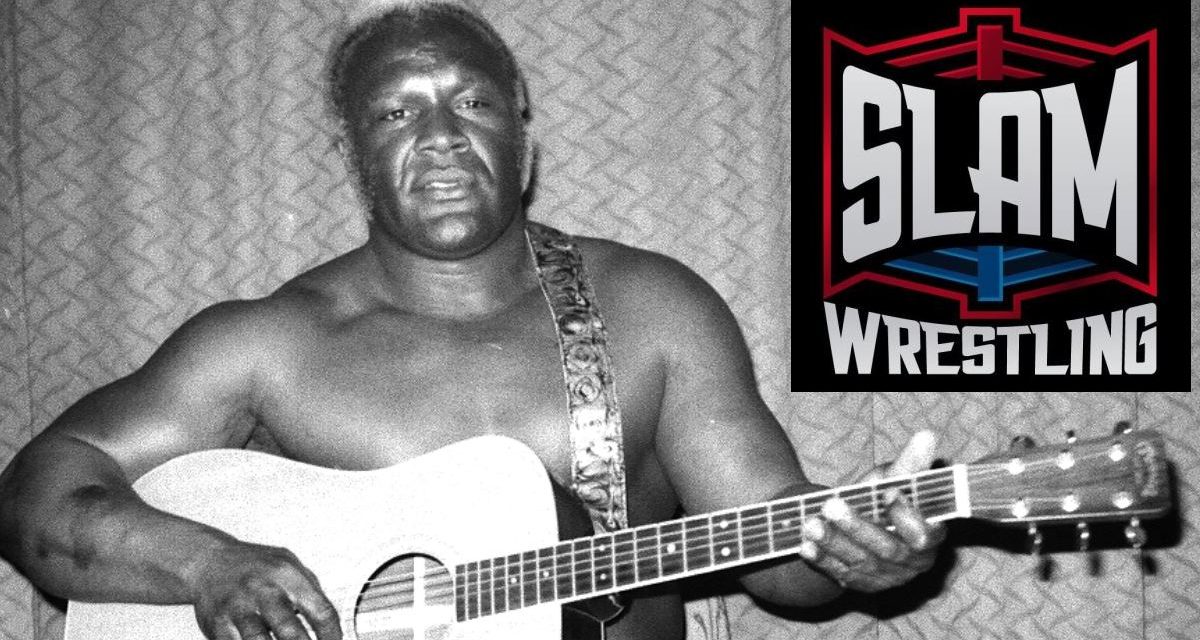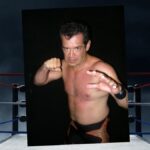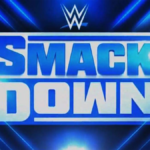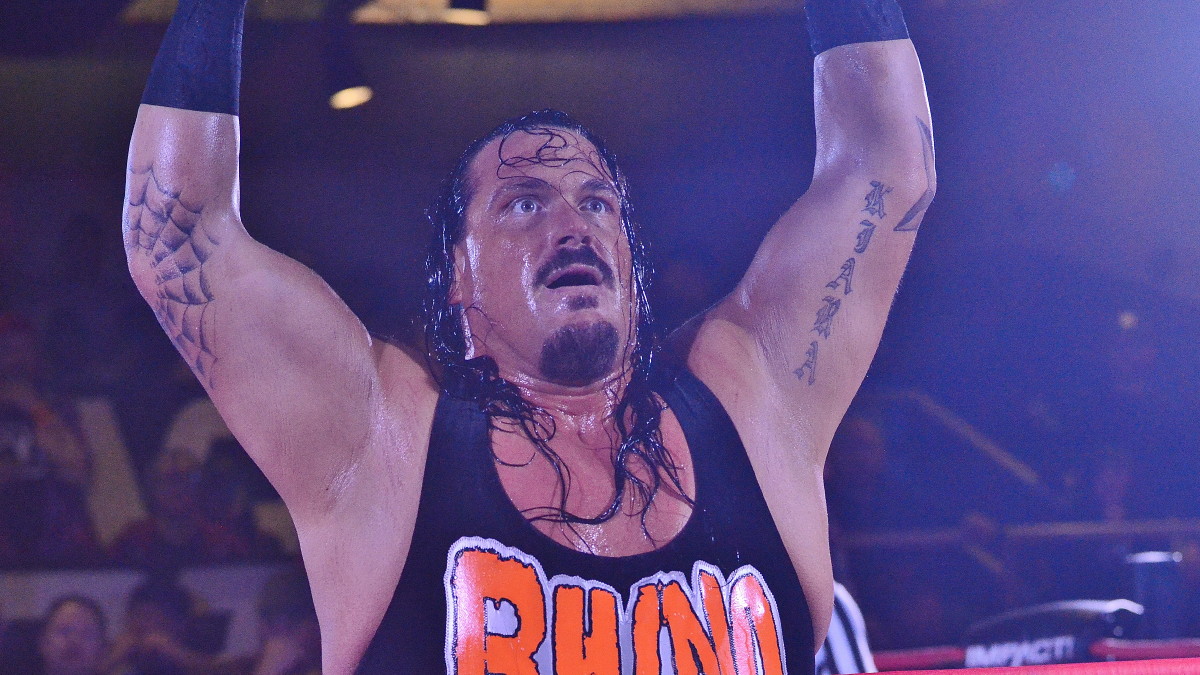Many musicians have had a passing interest in wrestling, but none have maintained a steady love for it more so than the rockabilly icon, Johnny Legend. In this, the second part of our interview with the Rockabilly Rasputin, Legend talks about Classy Freddie Blassie and writing Pencil Neck Geek, his battles with censorship, and his experiences within wrestling, from indy shows to ECW.
CLASSY FREDDIE BLASSIE
The faded star Gorgeous George may have been Johnny Legend’s first brush with wrestling stardom, but it was another wrestling superstar of the era, Classy Freddie Blassie, who became a true friend. If George was on a decline, Blassie was at his peak in the early ’60s. Legend started going to Los Angeles’ famous Olympic Stadium, using L.A.’s infamous public transit, taking him three hours to get there one way.
Legend was noticed first as a photographer at these wrestling events. “I got a reputation of one of the best cameramen at the Olympic. They let me go down to the front row and sit with the press,” Legend states with pride. “[The promoters would say], ‘There is that kid who takes the good pictures with the $8 Kodak camera.'”
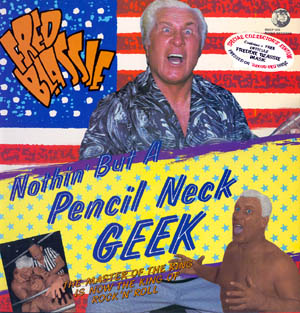
As a recognized wrestling photographer, the wrestlers allowed Legend the rare privilege of penetrating their secretive world. While some wrestlers maintained their kayfabe identities around him, Blassie would never stay in character when behind the scenes or outside of the arena. “Fred was always one of the nicest guys in the world. I had to coax him to get a ferocious look on his face,” Legend laughs.
Unlike others who tend to exaggerate, Legend has firm documentary proof of his involvement with Blassie and the other wrestlers: he has 8mm films of Blassie, Al Costello, Hard Boiled Haggerty, and many other wrestlers with him. Legend realizes that this footage is very rare, from an era when wrestlers would rarely allow themselves to be filmed breaking kayfabe.
Much of these early films were shot when the wrestlers were relaxing at Muscle Beach, at the Santa Monica Pier. “Fred would be reading a book and he let us interrupt him and hang with him all day,” Legend remembers. He promises to include some of this footage in upcoming DVD releases.
Legend and his friends went on to start one of the earliest Blassie Fan Clubs, complete with its own newsletters. For these young teenagers, this itself had a lot of perks. “We’d start getting fan letters from girls, sending us photos of them with bikinis,” he states with some naughtiness in his voice. Thinking that their photos would end up in the hands of Blassie or figurehead club president, teen actor Jay North, Legend and his friends worked these girls as much as they could, going so far as to write responses to them pretending that they were North.
THE ROCK(ABILLY) N’ WRESTLING CONNECTION
In the early ’70s, Legend’s Rockabilly work began getting noticed by the music world with his band, Blue Midnight. But he did not forget his passion for wrestling while a musician: he decided to approach his icon, Blassie, to record a song. Called Pencil Neck Geek, it has become one of the most recognizable wrestling songs in history. “They should put on my tombstone: the man who wrote Pencil Neck Geek,” Legend declares.
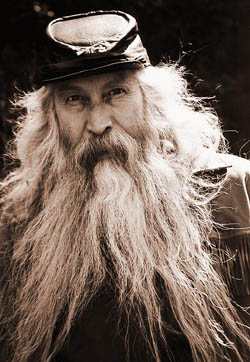
Johnny Legend
Rather than becoming the one-hit wonder that it did for Blassie, Legend wanted to do an entire album with the Classy one. “Billy Zoom was going to be a part of it, who later went on to be a part of [influential punk band] X,” Legend reveals. A big Blassie fan, scheduling conflicts did not allow Zoom to perform on the album. One can fantasize that had history been different, Zoom’s involvement with Blassie might have eventually led to Viggo Mortensen being part of wrestling history, as Mortensen married Zoom’s X bandmate, the haunting singer, Exene Ce.rvenka [www.exenecervenka.com.]
Legend did not want to stop there. In 1976, he thought about doing a joint wresting/rock show. “I was hanging around with George Thorogood, who was [both] a big wrestling fan, and a big Blassie fan, and we wanted to do a combined wrestling and rock show,” Legend explains. “The whole thing was the bands would have performed in the ring, not somewhere else. I had worked out all the logistics and audio.”
Once again, circumstances prevented this dream from coming to fruition. Legend continued with his Rockabilly career. It wasn’t until 1985 that he would be able to take his ideas to the next level, but he wouldn’t be able to do so without the help of the King. Not Elvis Presley, but the real King, Jerry Lawler.
Lawler and Legend put on a show called “Rock and Roll Wrestling,” and Legend puts over Lawler big time in terms of making the venture happen. Legend says that his own contributions involved having the wrestlers use 1980s alternative and new wave as their theme music, while other promotions were still using 1970s rock. To Legend, mixing wrestling with the most current and alternative music is the way to hook new fans, back then and to this day.
To coincide with the show and eventual video of Rock and Roll Wrestling, Legend convinced the cutting edge label Rykodiscs to put out an album featuring wrestlers singing rock tunes, that featured Lawler and future Minnesota Governor Jesse “The Body” Ventura, among others. “By a strange twist of fate, WWF’s wrestling record came out the same week as ours did,” Legend points out, and he heard through various sources that Stamford was not pleased at this coincidence whatsoever.
What further irritated them was that “We sold 25,000 videos of Rock N Roll Wrestling, and Coliseum Video told me that we sold as much as one of their WWF videos.”
THE PEOPLE VERSUS JOHNNY LEGEND: WRESTLING WITH CENSORSHIP
Irritating America’s most successful wrestling promoter did not figure on Legend’s radar. Throughout his career, he has had far more powerful opponents coming after him. A humble man who only spoke about this after much goading, Legend finally spoke about his crusades to defend the First Amendment over the decades.
One of Legend’s many interesting experiences was working as a checker for the adult film industry in the 1970s. A long forgotten profession, checkers would be dispatched by producers to various adult cinemas across America to count the patrons seeing their films, to ensure that they were not being ripped off by unscrupulous theater owners. The counting done, checkers would also be paid to watch these adult films, to make sure they were being shown in their entirety.
Legend took full advantage of being able to see most of America at his employers expense. “It was a real Jack Kerouac thing for me, going on the road,” Legend recalls fondly. As luck would have it, Legend’s career as a checker coincided with the release of his employer’s film Deep Throat, which became the most controversial adult film in the history of the genre.
Legend saw the film being protested coast-to-coast, with people calling not only for it to be banned, but adult cinema in its entirety. He was able to see the same people who later made life a living hell for Larry Flynt, and realized that if this self-appointed group that might as well have been called the Ministry to Promote Virtue and Eliminate Vice had their way, freedom of speech would have become a distant memory.
One town in particular sticks out in his mind in terms of its viciousness back in the 1970s: “I was in Carolina Beach, North Carolina. Various church groups in that town tried to get the police involved to try and ban the screening of Deep Throat.” As much as it horrified Legend personally, his employer decided to allow the church groups to pre-screen Deep Throat, to determine if cuts should be made or if it should be banned from the town outright. Reminiscent of the oppression of past and present religious theocracies, the young Legend could not allow the First Amendment to be manipulated in such a dangerous way, so he came up with his solution.
“We gave them what they wanted,” Legend says with glee. “I was good friends with the projectionist, so we decided to pull a trick where we interjected scenes from [a hardcore film called] Teenage Fantasies during certain scenes of Deep Throat.” Of course, no one knew what Legend was doing, since he was able to cut between both films almost seamlessly. Needless to say, those scenes from Teenage Fantasies made the Deep Throat scenes seem like The Little Mermaid.
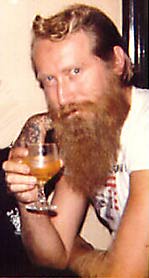
A younger Johnny Legend.
The self-appointed censors of the town were thoroughly disgusted by what they had seen. At a town council meeting soon after the screening, the leaders of this group stood up and gave speeches full of fire and brimstone, calling for it to be banned, and the theatre to be shut down and razed. “The head pastor in the town later spoke up at a town meeting, with tears in his eyes, saying it was the most horrible thing he had ever seen, and definitely the work of the devil. He started describing the scenes, and quoting the explicit dialogue verbatim,” Legend says, while imitating the voice of the religious zealot.
Legend’s brilliance then reveals itself: the head pastor’s veracity was called into question because he was describing a film that wasn’t Deep Throat. An unlikely source came to the rescue of the film after the pastor’s peroration.
“One of the town’s top policeman, who loved and knew his porn, stood up and laughed, saying to him, ‘You went and saw the wrong film, pastor. That’s Teenage Fantasies,” Legend laughs. “The pastor then was so humiliated and sat down, like a broken man. The screening of Deep Throat went on as planned after that,” and Carolina Beach’s self-appointed censors never bothered that theatre again while Legend was there.
Legend was so inspired by his own victories that he decided to make adult entertainment films of his own. He is one of the foremost historians of American adult entertainment, and one of his aforementioned heroes also shared a love of this genre of film. “Fred Blassie was a porno fan,” Legend says as a matter-of-fact. “He didn’t know much about film other than pornos. [He used to say], ‘Unless it’s John Wayne or Paul Newman, I don’t know who the hell you’re talking about!'”
Legend’s first adult entertainment film was called Teenage Cruisers, released in 1977. Combining Rockabilly music with adult entertainment, it became an underground classic of its time.
Most recently, Legend made an adult film entitled Nympho Libre, in 2007. No doubt capitalizing upon the successful farce, Nacho Libre, Legend’s film is notable for being a pastiche of various art forms: adult films, lucha libre wrestling, and, most importantly “Tijuana Bibles.” Tijuana Bibles were subversive comic books depicting sexuality, and popular between the 1920s and 1960s, sometimes featuring satires of popular comic book characters such as The Archies, but engaging in acts that would have been more at home in Hustler. In today’s world, Japanese hentai anime would be the closest thing to a Tijuana Bible. Legend admits, “It was an excuse to shoot something with wrestling scenes, but it turned into something really avant-garde.”
Far from being an unknown film, Nympo Libre became a hot seller at mainstream video and CD sellers across America, and could be found at the (now defunct) Tower Records under their wrestling DVD section, not condemned to a life in seedy XXX video stores.
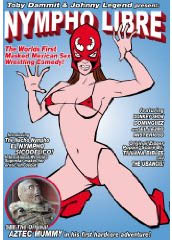
Legend’s adult films were so mainstream that his old friends at Rykodiscs, picked up both Nympo Libre and Teenage Cruisers, introducing the latter film to a whole new generation of fans. By this time, however, Ryko had a bottomless pit of money to promote Legend’s DVDs, since they were now owned by Warner Brothers. “Ryko said we’ll throw caution to the wind,” and heavily promote these films, Legend says. “Tower Records was even planning to put up displays all over the country,” advertising Nympho Libre.
If a new generation of counter-culture fans were discovering Legend’s work, the law of physics would demand an equal and opposite reaction from a new generation of cultural prudes and censors. The newspaper juggernaut, the New York Post, published a scathing piece on its infamous Page 6 in July 2008, condemning Warner Brothers for distributing Legend’s Teenage Cruisers. Almost instantly, the Post‘s readers inundated Warner Brothers with calls, feigning great moral indignation. “Warner blew a gasket,” according to Legend. Unlike the 1970s, the forces of closed-mindedness and censorship won this battle.
Demonstrating his magnanimity, Legend was less concerned about his own DVD being banned, but more about the other films that have now been banned as a result of the attention given to his films. “Ryko had no comeback, and shut down their entire erotic art-film catalogue, which is almost half their library,” Legend says with consternation in his voice.
But for Legend, there was a silver lining in all of this: the publicity he garnered from the New York Post caused there to be a renaissance of his works, not just of his adult films, but of his work in Rockabilly and wrestling. In fact, the DVD producers can hardly keep up with the orders of Nympo Libre these days, with orders for it coming all over the world. “It’s become a cult classic already, with a strong fan following in Russia right now.”
A SATURDAY NIGHT LIVE STAR MEETS A LEGEND
Legend’s wrestling shows in L.A., first called Incredibly Strange Wrestling (ISW), and then Johnny Legend’s Incredibly Strange Rock and Roll Wrestling after he broke with ISW, continued to attract both mainstream wrestling fans, but also non wrestling fans.
The combination of Rockabilly bands playing with American wrestlers, and Lucha Libre stars, provided a forum for fans of all of those genres.
Hollywood celebrities became a constant presence at his shows — stars who would otherwise not be caught dead at a mainstream wrestling event. Legend’s genius decided to take advantage of the Hollywood glitterati in his crowd, and came up with a tag team in the late ’90s called “Los Paparazzi.” They would come to the ring with their cameras, and take photos of their opponents when decimating them.
To illustrate Legend’s innovative thinking, he would have Los Paparazzi be ready to pin their opponents, but then announce over the speakers that such-and-such Hollywood star was spotted sitting in a certain row of the audience. The tag team would then leave the ring, pick up their cameras, and start taking photos of the celebrities. Meanwhile, their nearly defeated opponents would have a chance to recover, and often beat Los Paparazzi minutes later.
One celebrity who fell victim to Los Paparazzi’s antics was Saturday Night Live star Chris Farley.
“Two weeks before he died, Chris Farley was there. And I had the match planned out so that before Los Paparazzis was going to get the pin, the ring announcer would tell them that a celebrity was there,” Legend says. “Chris Farley was drunk out of his mind, and he was going to fall down, so I propped him up on the ring post. He was so out of it, he couldn’t get into the ring.”
Despite the humor of the situation at the time, Legend looks back and reflects upon the fact that Farley was really in terrible shape, and totally out of control with his addictions. He then recollects with some sadness that Farley seemed to be totally alone:
“At the end of the night, at three in the morning, Farley was still there. I felt strange, since he didn’t want to leave. Some Mexican wrestlers saw him there, and he asked them for a ride home. They didn’t know who Farley was, so they’d say to me, ‘Who is this fat son of a bitch?’ Two weeks later, he died. It was just tragic.”
LEGEND’S THOUGHTS ON WRESTLING TODAY
Legend continues to be a fan of wrestling today, watching WWE and TNA religiously every week. But he sees a decline in it. “If you look up fast forward in the dictionary, you’ll find the WWE logo there,” Legend remarks. He respects the wrestlers in the WWE, but mourns the fact that they are trapped in stale storylines.
He also feels that the agents should be allowed to give the WWE wrestlers more freedom. He knows the orders come from higher up, but he feels that the agents should not be in an environment where they are afraid to suggest something new to the wrestlers under their supervision. Everything, for Legend, has become all too predictable in terms of the in-ring action, not to mention the repetitive storylines. “With the WWE, if the match starts with one wrestler getting a lot of offense in the start, they will end up losing in the end,” Legend says with some frustration in his voice. “It’s the same thing, over and over.”
He feels TNA can also use improvement, but finds a few aspects of their show to be on the right track. He singles out their Women’s Division, in particular, for praise. “The way TNA handled the introduction of Taylor Wilde was well done,” he says, and represents how wrestling storylines can be made appealing to current viewers.
He believes their top star and someone who is destined to be an amazing heel women’s champion is Canadian Angelina Love. “She is really sharp. She’s a lot sharper than people give her credit for,” both in terms of her wrestling and her charismatic delivery of her promos, Legend says.
For those who are unaware, Legend is still the undefeated A.I.W.A. Women’s Championship, a belt he has held upwards of 13 years, and knows of what he speaks. He is no coward, and is challenging the most feared Women’s wrestler today: “Awesome Kong: I’m calling you out!!!”
When asked what his favorite televised or PPV show has been since the 1990s, he points to Paul Heyman’s ECW.
“I was there in Philadelphia [in 1995,] that one fateful night that Sabu came back. Eddy Guerrero [Guerrero] was there, Rey [Mysterio Jr.] was there. Paul E. Dangerously did a lot of great things [with ECW],” Legend says without hesitation.
During that show in 1995, Heyman quietly acknowledged Legend, without the latter’s knowledge. At one point in the show, “Joey Styles was standing next to me doing a wraparound,” Legend recollects, keeping him in shot of the camera. They didn’t mention Legend’s name, but a number of his friends, such as Rey Mysterio Jr., ran to him later to tell him that he was on the screen for a few minutes. Legend was touched by this.
“I never had the chance to talk to Paul E [during the show],” Legend says, and he didn’t want to disturb him. But he recognized his brilliance first hand when seeing that show.
One is pleasantly surprised by the coincidence that Legend feels a kinship most with a younger wrestling promoter who also got his start in the business as a wrestling photographer.
A LEGENDARY LEGACY
Legend ends the interview on an upbeat note, leaving one energized not just about wrestling, but about life. Legend reveals a joie de vivre that makes one understand why it is hard to find anyone who will say a bad word about him in a business that thrives upon backstabbing. In a world of the bizarre and insane, Legend lives up to his name: he is truly a one-of-kind character that leaves a lasting impression long after most wrestling fixtures have either faded away into obscurity or eroded from within. It is passion that drives Legend, an unbridled and unrepentant love for all things against what society deems “normal.”
One need not have met Legend in order to feel his influence. His theatrical Rockabilly shows and music referring to wrestling and horror films influenced the newer genre of music, Psychobilly, and whether they know it or not, one can feel Legend’s presence in the shows of Tiger Army and the cutting edge HorrorPops [www.horrorpops.com].
Look at wrestling fans. Horror film fans. Psychobilly fans. What unites them? What is the one thing that links them all together in a chain that most politically correct groups would call “socially unfit” pastimes? Passion. Give the fans something they can hold on to, something unique and that they can call their own and you’ll have them forever. Passion is the mortar that binds the stones in the Church of Legend.
But behind the flowing white beard and crazed smile lies the crafty mind of a veteran, not just of the squared circle but also of the world stage itself. Whether he can be found belting out some raucous Rockabilly tunes, or in front of the camera in films produced by Disney’s Miramax, or cult film director Tim Sullivan’s sequel to his terrific film remake of 2001 Maniacs, Legend has conquered all that has come his way. As Legend himself says, “I’ve made a living from Deep Throat to Disney.”
Ranjan Chhibber is a former WWE TV Writer with a Ph.D. in Film History, and an award winning academic, who has taught Film Studies at various universities across the United States and Canada. Special thanks to Kurt Brown for arranging the interview.
